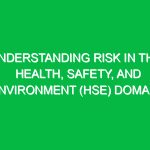Introduction to Biological Hazards
Biological hazards, often referred to as biohazards, are organisms or substances derived from living organisms that pose a threat to human health or the environment. This can include bacteria, viruses, fungi, parasites, and even biological toxins. As Health, Safety, and Environment (HSE) professionals, understanding biological hazards is crucial. These hazards can lead to severe illnesses, workplace accidents, and environmental pollution if not managed properly.
In various sectors—such as healthcare, agriculture, and waste management—HSE professionals encounter biological hazards daily. For instance, a nurse may face exposure to pathogens in a hospital setting, while a farmer may deal with zoonotic diseases transmitted from animals to humans. The relevance of biological hazards extends beyond mere statistics; it involves real-life implications for health and safety in the workplace and community.
Identifying Biological Hazards
Understanding potential hazards is the first step in effective management. Biological hazards can be categorized into several types, each presenting unique risks.
1. Bacteria and Viruses
Bacteria and viruses can be found in various environments, particularly hospitals, laboratories, and agricultural settings. For example, *Escherichia coli* (E. coli) can contaminate food and water supplies, leading to severe gastrointestinal issues. Meanwhile, viruses like influenza or SARS-CoV-2 can spread rapidly, causing widespread health crises.
2. Fungi
Fungi, including molds and yeasts, can pose risks, especially in damp environments. Fungal spores can cause respiratory issues and allergies. An example is *Aspergillus*, which can lead to serious lung infections in immunocompromised individuals.
3. Parasites
Parasites, such as worms and protozoa, can be transmitted through contaminated food or water. A common example is Giardia, which can cause gastrointestinal illness when ingested from untreated water sources.
4. Biological Toxins
Certain organisms produce toxins that can be harmful to humans. For instance, the toxin produced by the *Clostridium botulinum* bacterium leads to botulism, a potentially fatal illness.
5. Zoonotic Diseases
Zoonotic diseases are transmitted from animals to humans. Examples include rabies and West Nile virus. Understanding the transmission pathways of these diseases is essential for HSE professionals working in sectors like veterinary medicine and wildlife management.
Risks Associated with Biological Hazards
The risks posed by biological hazards are multifaceted, affecting not just individual health but also public safety and environmental integrity.
1. Health Risks
Health risks from biological hazards can range from mild infections to severe diseases and even death. For instance, healthcare workers exposed to infected patients may contract diseases like hepatitis or HIV. According to the World Health Organization (WHO), healthcare-associated infections can affect hundreds of millions of patients worldwide annually.
2. Environmental Impact
Biological hazards can also contribute to environmental degradation. For example, agricultural runoff containing pathogens can contaminate water sources, affecting both wildlife and human populations. An incident in the late 1990s in North Carolina highlighted how hog farms contributed to water pollution, leading to adverse health effects in nearby communities.
3. Economic Consequences
The economic impact of biological hazards can be staggering. Outbreaks of diseases can lead to significant healthcare costs, loss of productivity, and even long-term economic downturns in affected regions. The COVID-19 pandemic serves as a stark reminder of how a biological hazard can disrupt economies worldwide.
Safety Precautions and Best Practices
To mitigate the risks associated with biological hazards, HSE professionals must implement robust safety precautions and best practices.
1. Risk Assessment
Conducting a thorough risk assessment is essential. This involves identifying potential biological hazards in the workplace, evaluating exposure risks, and implementing appropriate control measures. For instance, a laboratory working with dangerous pathogens should have stringent protocols in place to prevent accidental exposure.
2. Personal Protective Equipment (PPE)
Using appropriate PPE is vital in minimizing exposure to biological hazards. This includes gloves, masks, gowns, and face shields, depending on the level of risk. For example, healthcare workers treating patients with infectious diseases must adhere to strict PPE protocols to protect themselves and others.
3. Hygiene Practices
Implementing good hygiene practices can significantly reduce biological hazard risks. Regular handwashing, sanitizing surfaces, and properly disposing of biological waste are fundamental practices that can prevent the spread of infectious agents.
4. Training and Awareness
Regular training and awareness programs for employees are crucial. Workers should be educated about the types of biological hazards they may encounter, proper handling procedures, and emergency response protocols. For instance, a training session on handling sharps and potential bloodborne pathogens can save lives.
5. Vaccination
Vaccination is another critical preventive measure against certain biological hazards. Healthcare workers, for example, should be vaccinated against hepatitis B and influenza to reduce their risk of infection.
Regulations and Standards Governing Biological Hazards
Regulatory bodies have established guidelines and standards to help manage biological hazards effectively.
1. Occupational Safety and Health Administration (OSHA)
In the United States, OSHA provides regulations for workplace safety, including standards for bloodborne pathogens (29 CFR 1910.1030). These standards dictate how to handle and dispose of materials that may be contaminated with blood or other potentially infectious materials.
2. Centers for Disease Control and Prevention (CDC)
The CDC offers guidelines for preventing and controlling biological hazards, particularly in healthcare settings. Their document titled “Infection Control Guidelines” provides comprehensive strategies for reducing the risk of infection.
3. World Health Organization (WHO)
The WHO develops international guidelines for managing biological hazards, particularly in the context of public health. Their resources are invaluable for HSE professionals working in global health or emergency response.
4. National Institute for Occupational Safety and Health (NIOSH)
NIOSH conducts research and makes recommendations for the prevention of work-related injuries and illnesses, including those caused by biological hazards. Their recommendations often include exposure limits and control measures.
Conclusion
Understanding biological hazards is vital for HSE professionals dedicated to ensuring workplace safety and public health. By identifying potential risks, implementing effective safety precautions, and adhering to established regulations, we can significantly reduce the adverse effects associated with these hazards. As the world becomes increasingly interconnected, the importance of vigilance in managing biological hazards cannot be overstated. Real-life situations, such as the recent global pandemic, serve as a reminder of the potential dangers lurking in our environment. The responsibility lies with us to safeguard health and safety for ourselves and future generations.


